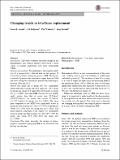Files in this item
Changing trends in total knee replacement
Item metadata
| dc.contributor.author | Goudie, Ewan | |
| dc.contributor.author | Robinson, Cal | |
| dc.contributor.author | Walmsley, Phil | |
| dc.contributor.author | Brenkel, Ivan | |
| dc.date.accessioned | 2017-03-14T17:30:17Z | |
| dc.date.available | 2017-03-14T17:30:17Z | |
| dc.date.issued | 2017-05 | |
| dc.identifier | 249351060 | |
| dc.identifier | 9e6eb576-d24d-4a4f-a4ec-eb9e1395ece7 | |
| dc.identifier | 28281089 | |
| dc.identifier | 85014702580 | |
| dc.identifier | 28281089 | |
| dc.identifier.citation | Goudie , E , Robinson , C , Walmsley , P & Brenkel , I 2017 , ' Changing trends in total knee replacement ' , European Journal of Orthopaedic Surgery and Traumatology , vol. 27 , no. 4 , pp. 539-544 . https://doi.org/10.1007/s00590-017-1934-8 , https://doi.org/10.1007/s00590-017-1934-8 | en |
| dc.identifier.issn | 1432-1068 | |
| dc.identifier.other | PubMedCentral: PMC5403846 | |
| dc.identifier.uri | https://hdl.handle.net/10023/10463 | |
| dc.description.abstract | Introduction: This study evaluates a possible change in the demographics and surgical practice observed in a large cohort of patients undergoing total knee replacement (TKR). Patients and methods: We performed a retrospective analysis of a prospectively collected data on two groups of consecutive patients undergoing primary TKR. Group one consisted of patients who underwent surgery between 1994 and 1998. Group two consisted of patients who had surgery between 2009 and 2012. Results: The mean age of group two was significantly greater than that of group one: 68.9 years (68.1–69.7 years) for group one versus 70.1 years (69.6–70.6 years) for group two (p = 0.009). The mean BMI of group two was significantly greater than that of group one: 29.5 kg/m2 (29.0–29.9 kg/m2) for group one versus 32.0 kg/m2 (31.7–32.3 kg/m2) for group two (p < 0.001). The mean pain component of the AKSS was significantly worse in group one than in group two: 28.6 (27.2–30.0) for group one versus 35.5 (34.6–36.4) for group two (p < 0.001). The mean function component of the AKSS was significantly worse in group one than in group two: 48.6 (47.3–49.9) for group one versus 51.5 (50.7–52.3) for group two (p < 0.001). Conclusion: This study describes the change in demographics of patients undergoing TKR in our institution over the last two decades. | |
| dc.format.extent | 6 | |
| dc.format.extent | 340764 | |
| dc.language.iso | eng | |
| dc.relation.ispartof | European Journal of Orthopaedic Surgery and Traumatology | en |
| dc.subject | Osteoarthritis | en |
| dc.subject | Total knee replacement | en |
| dc.subject | Demographics | en |
| dc.subject | BMI | en |
| dc.subject | RZ Other systems of medicine | en |
| dc.subject | NDAS | en |
| dc.subject.lcc | RZ | en |
| dc.title | Changing trends in total knee replacement | en |
| dc.type | Journal article | en |
| dc.contributor.institution | University of St Andrews. School of Medicine | en |
| dc.identifier.doi | https://doi.org/10.1007/s00590-017-1934-8 | |
| dc.description.status | Peer reviewed | en |
This item appears in the following Collection(s)
Items in the St Andrews Research Repository are protected by copyright, with all rights reserved, unless otherwise indicated.

